
Greater Queens Podiatry, PLLC
 (718) 229-0222
(718) 229-0222
 (718) 229-0222
(718) 229-0222When it comes to maintaining foot health, wearing properly-fitting shoes is important. While wearing the appropriate pair of shoes may seem like a trivial concern, the reality is that improperly fitted shoes cause an astounding amount of injuries to the feet. The overall structure and the biomechanics of our bodies are directly affected by our posture, gait, and feet. Because of this, pain and discomfort felt throughout the body are often related to a problem in the feet. And, most foot problems usually stem from improper footwear.
Shoes should not be purchased with the expectation that they will easily stretch and contort to the size and shape of your feet. When shopping for footwear, look for shoes that fit correctly and comfortably as soon as you put them on. Do not purchase shoes that are too large or that slip in the heel area when you walk. Do not choose shoes that are loose with the intention of wearing thicker socks to compensate for the space. The widest portion of the shoe, the ball of the foot, must be made sure to fit comfortably in the shoe.
Keeping all of these suggestions in mind may be difficult when shopping and when trying to select from a wide array of different shoes. Nonetheless, your time and money will be wasted if you purchase a pair of shoes that are too uncomfortable for you to actually wear them. After finally selecting and purchasing a pair of shoes, try them on at home. To truly ensure whether or not your shoes fit comfortably with normal activity, walk around on a carpeted surface to determine how they feel on your feet.
The possibility of damaging your feet’s 33 joints, 26 bones, and 100+ ligaments is much higher than many people suspect. Finding an appropriate and properly-fitted pair of shoes is perhaps the single most important action you can take to maintain excellent foot health and help prevent injury. The fact that our feet continue to change with age is one that many people often forget. Even if our feet no longer change in size when we mature, our feet will still change in shape.
If you already have pre-existing foot problems, there is a greater possibility that wearing improperly-fitted shoes will worsen those problems. The good news, however, is that appropriate footwear is not difficult to find. While shopping for shoes, remember that improper footwear can detrimentally affect the feet, the entire body and its biomechanical structure as well. The shoes you wear can greatly impact your legs, back, and entire body, as your posture and gait are related to your feet. Finding and selecting the best properly-fitted shoes is necessary in achieving optimal health.
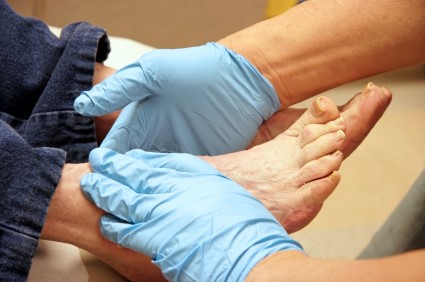 “If you want to know the state of your health, try looking down.” Poor circulation in a person’s feet can be caused by a variety of things, and it is vitally important not to ignore any hint that this may be happening to you. Symptoms to look out for include cold feet, numbness, pain, or swelling. Diabetes can lead to poor circulation in the extremities and if left untreated, can wreak havoc on your feet. But there are many other reasons for lack of blood flow, including neurological issues, Peripheral Artery Disease (PAD), and smoking, among others. Causes of these symptoms can become serious so it is imperative get to a podiatrist immediately to find out what is going on.
“If you want to know the state of your health, try looking down.” Poor circulation in a person’s feet can be caused by a variety of things, and it is vitally important not to ignore any hint that this may be happening to you. Symptoms to look out for include cold feet, numbness, pain, or swelling. Diabetes can lead to poor circulation in the extremities and if left untreated, can wreak havoc on your feet. But there are many other reasons for lack of blood flow, including neurological issues, Peripheral Artery Disease (PAD), and smoking, among others. Causes of these symptoms can become serious so it is imperative get to a podiatrist immediately to find out what is going on.
Poor circulation is a serious condition and needs immediate medical attention. If you have any concerns with poor circulation in your feet contact one of our podiatrists from Greater Queens Podiatry. Our doctors can provide the care you need to keep you pain-free and on your feet.
Poor Circulation in the Feet
Poor blood circulation in the feet and legs is can be caused by peripheral artery disease (PAD), which is the result of a buildup of plaque in the arteries.
Plaque buildup or atherosclerosis results from excess calcium and cholesterol in the bloodstream. This can restrict the amount of blood which can flow through the arteries. Poor blood circulation in the feet and legs are sometimes caused by inflammation in the blood vessels, known as vasculitis.
Causes
Lack of oxygen and oxygen from poor blood circulation restricts muscle growth and development.
It can also cause:
· muscle pain, stiffness, or weakness
· numbness or cramping in the legs
· skin discoloration
· slower nail & hair growth
· erectile dysfunction
Those who have diabetes or smoke are at greatest risk for poor circulation, as are those who are over 50. If you have poor circulation in the feet and legs it may be caused by PAD, and is important to make changes to your lifestyle in order to reduce risk of getting a heart attack or stroke. Exercise and maintaining a healthy lifestyle will dramatically improve conditions.
As always see a doctor as they will help try and fit a regime that suits you. A doctor will also prescribe you medication which will help for PAD.
If you have any questions please feel free to contact our office located in Bayside, New York. We offer the newest diagnostic and treatment technologies for all your foot and ankle needs.
For hundreds of years, women have been wearing various kinds of high-heels for aesthetic reasons. Women who wear high-heels appear to be taller and have longer and thinner legs, and the wearer’s gait and posture changes. Though high-heels have had an association with femininity and have kept them popular over the years, there are definite health problems caused by wearing them too frequently.
The motion of the ankle joints is limited when heels are worn. The ankle joint is very important to the body when it comes to walking. Because of their location, these joints have a great deal of weight put on them. Thus, it is very important to keep them as healthy as possible. The Achilles tendon is the main tendon in the ankle. Wearing high-heels too often, studies have shown, can cause the calf muscle and Achilles tendon to shorten and stiffen. This can cause problems when shoes without heels are worn.
By putting a great deal of pressure on the ball of the foot and by forcing the toes into a small toe box, high-heels can cause or may worsen many foot problems. These include corns, hammertoe, bunions, Morton’s neuroma and plantar fasciitis.
Not only does wearing very high-heels regularly have negative effects on the feet, the rest of the body can suffer as well. The knees, one of the most important joints in the entire body, can be affected by wearing high-heels. High-heels causes the knees to stay bent all the time. Also, it can cause them to bend slightly inward as well. Doctors believe that women can suffer from osteoarthritis later in life because of constantly walking like in high-heels. By limiting the natural motion of the foot during walking, high-heels also cause an increased in stress on the knees.
Similarly, high-heels can cause the back to go out of alignment. If high-heels are worn constantly, the spine’s ability to absorb shock can cause continued back pain. They can compress the vertebrae of the lower back, and can overuse the back muscles.
However, this is not to say that high-heels can never be worn. If worn occasionally and not often, they will not cause serious problems. They should not be worn every day. It’s important to wear them modestly to avoid the long-term physical health problems of the feet, knees, ankles, and back mentioned above.
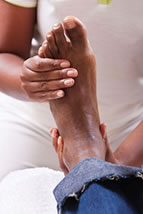 Ingrown toenails are a common foot problem and occur when the toenail begins growing into the skin on its sides. This, consequently, can lead to infections, swelling and irritation. You can prevent ingrown toenails by cutting your toenails straight across from end to end. Avoid improperly-fitting shoes, as they can squeeze your toes, potentially impacting how your toenails grow. Contact sports such as soccer that require an object to constantly impact the feet can also lead to an increased chance of ingrown toenails. If you think you may have an ingrown toenail, seek the advice of your podiatrist. While at home, soak your toenail in warm water with salt and apply antibiotic ointment afterwards. Avoid any tight bandages or socks.
Ingrown toenails are a common foot problem and occur when the toenail begins growing into the skin on its sides. This, consequently, can lead to infections, swelling and irritation. You can prevent ingrown toenails by cutting your toenails straight across from end to end. Avoid improperly-fitting shoes, as they can squeeze your toes, potentially impacting how your toenails grow. Contact sports such as soccer that require an object to constantly impact the feet can also lead to an increased chance of ingrown toenails. If you think you may have an ingrown toenail, seek the advice of your podiatrist. While at home, soak your toenail in warm water with salt and apply antibiotic ointment afterwards. Avoid any tight bandages or socks.
Ingrown toenails can become painful if they are not treated properly. For more information about ingrown toenails, contact one of our podiatrists from Greater Queens Podiatry. Our doctors can provide the care you need to keep you pain-free and on your feet.
Ingrown Toenails
Ingrown toenails occur when a toenail grows sideways into the bed of the nail, causing pain, swelling, and possibly infection.
Causes
Bacterial infections
Improper nail cutting such as cutting it too short or not straight across
Trauma to the toe, such as stubbing, which causes the nail to grow back irregularly
Ill-fitting shoes that bunch the toes too close together
Genetic predisposition
Prevention
Because ingrown toenails are not something found outside of shoe-wearing cultures, going barefoot as often as possible will decrease the likeliness of developing ingrown toenails. Wearing proper fitting shoes and using proper cutting techniques will also help decrease your risk of developing ingrown toenails.
Treatment
Ingrown toenails are a very treatable foot condition. In minor cases, soaking the affected area in salt or antibacterial soaps will not only help with the ingrown nail itself, but also help prevent any infections from occurring. In more severe cases, surgery is an option. In either case, speaking to your podiatrist about this condition will help you get a better understanding of specific treatment options that are right for you.
If you have any questions please feel free to contact our office located in Bayside, New York. We offer the newest diagnostic and treatment technologies for all your foot and ankle needs.
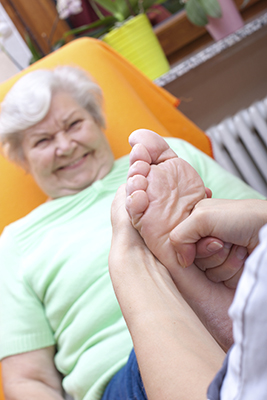 If you have diabetes, you may know that proper management of your feet is vital toward your overall health. Diabetic feet are especially prone to infection and foot ulcers. Take care of your diabetic feet with the following tips. Make sure to properly wash and dry your feet, moisturizing any dry areas. Manage your toenails by cutting them appropriately. Avoid taking hot baths and wear only breathable socks and footwear that do not squeeze your feet and can potentially impact your circulation. Avoid going barefoot, especially in public places. See your doctor immediately if you think you may encounter any foot complications such as sensitivity in the feet, an infection or foot sore.
If you have diabetes, you may know that proper management of your feet is vital toward your overall health. Diabetic feet are especially prone to infection and foot ulcers. Take care of your diabetic feet with the following tips. Make sure to properly wash and dry your feet, moisturizing any dry areas. Manage your toenails by cutting them appropriately. Avoid taking hot baths and wear only breathable socks and footwear that do not squeeze your feet and can potentially impact your circulation. Avoid going barefoot, especially in public places. See your doctor immediately if you think you may encounter any foot complications such as sensitivity in the feet, an infection or foot sore.
Diabetic foot care is important in preventing foot ailments such as ulcers. If you are suffering from diabetes or have any other concerns about your feet, contact one of our podiatrists from Greater Queens Podiatry. Our doctors can provide the care you need to keep you pain-free and on your feet.
Diabetic Foot Care
Diabetes affects millions of people every year. Diabetes can damage blood vessels in many parts of the body, including the feet. Because of this, taking care of your feet is essential if you have diabetes, and having a podiatrist help monitor your foot health is highly recommended.
The Importance of Caring for Your Feet
● Routinely inspect your feet for bruises or sores.
● Wear socks that fit your feet comfortably.
● Wear comfortable shoes that provide adequate support.
Patients with diabetes should have their doctor monitor their blood levels because blood sugar levels play such a huge role in diabetic care. Monitoring these levels on a regular basis is highly advised.
It is always best to inform your healthcare professional of any concerns you may have regarding your feet, especially for diabetic patients. Early treatment and routine foot examinations are keys to maintaining proper health, especially because severe complications can arise if proper treatment is not applied.
If you have any questions please feel free to contact our office located in Bayside, New York. We offer the newest diagnostic and treatment technologies for all your foot and ankle needs.
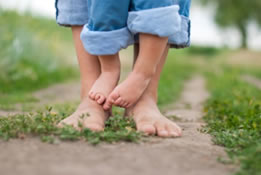 The number of cases of hand, foot and mouth disease (HFMD) are on the rise, especially among children at schools, as the disease is highly contagious. School administrators at the Ministry of Health advise that children who have the disease stay at home “for at least seven days.” Additionally, they advise that any immediate objects in the school environment should be cleaned frequently to help reduce the spread of the virus. Good hygiene as well as caution during close contact should be encouraged among your children to help toward prevention of HFMD.
The number of cases of hand, foot and mouth disease (HFMD) are on the rise, especially among children at schools, as the disease is highly contagious. School administrators at the Ministry of Health advise that children who have the disease stay at home “for at least seven days.” Additionally, they advise that any immediate objects in the school environment should be cleaned frequently to help reduce the spread of the virus. Good hygiene as well as caution during close contact should be encouraged among your children to help toward prevention of HFMD.
Making sure that your children maintain foot health is very important as they grow. If you have any questions, contact Dr. Nicholas Megdanis from Greater Queens Podiatry PLLC. Our doctor can provide the care you need to keep you pain-free and on your feet.
Keeping Children's Feet Healthy
Having healthy feet in childhood can help prevent medical problems later in life, namely in the back and legs. As children grow, their feet require different types of care from birth to school-age.
Although babies do not walk yet, it is still very important to take care of their feet.
· Avoid putting tight shoes or socks on his or her feet
· Allow the baby to stretch and kick his or her feet to feel comfortable
As a toddler, kids are now on the move and begin to develop differently. At this age, toddlers are getting a feel for walking, so don’t be alarmed if your toddler is unsteady or ‘walks funny’.
As your child gets older, it is important to teach them how to take care of their feet
Show them proper hygiene to prevent infections such as fungus
Be watchful of any pain or injury
Have all injuries checked by a doctor as soon as possible
Comfortable, protective shoes should always be worn, especially at play
If you have any questions please feel free to contact our office located in Bayside, New York. We offer the newest diagnostic and treatment technologies for all your foot and ankle needs.
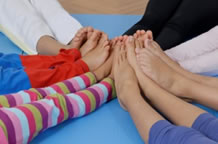 With 26 bones in each foot, our feet play a large part in our everyday activities. Therefore, it’s important to take care of our feet to prevent conditions such as arthritis or other ailments. The Huffington Post recommends some particular tips in ensuring proper foot care. These include wearing properly-fitting shoes that do not squeeze our feet and that accommodate your specific foot structure. If you have balance problems, going barefoot may help with stimulation of your foot structure. Walking on different surfaces and take note of your own gait.
With 26 bones in each foot, our feet play a large part in our everyday activities. Therefore, it’s important to take care of our feet to prevent conditions such as arthritis or other ailments. The Huffington Post recommends some particular tips in ensuring proper foot care. These include wearing properly-fitting shoes that do not squeeze our feet and that accommodate your specific foot structure. If you have balance problems, going barefoot may help with stimulation of your foot structure. Walking on different surfaces and take note of your own gait.
Every day foot care is very important to prevent infection and other foot ailments. If you need your feet checked contact Dr. Nicholas Megdanis from Greater Queens Podiatry PLLC. Our doctor can provide the care you need to keep you pain-free and on your feet.
Every Day Foot Care
Often, people take care of their bodies, face and hair more so than they do for their feet. But the feet are a very important aspect of our bodies, and one that we should pay more attention to. After all, without our feet, we would not be able to perform most daily tasks. It is best to check your feet regularly to make sure there are no new bruises or cuts that you may not have noticed before, for example.
For dry feet, moisturizer can easily be a remedy and can be applied as often as necessary to the affected areas. Wearing shoes that fit well can also help you maintain good foot health, as well as making it easier to walk and do daily activities without the stress or pain of ill-fitting shoes, high heels, or even flip flops.
Also, wearing clean socks with closed shoes is important to ensure that sweat and bacteria do not accumulate within the shoe. Clean socks help to prevent athlete’s foot, fungi problems, bad odors, and can absorb sweat.
If you have any questions please feel free to contact our office located in Bayside, New York. We offer the newest diagnostic and treatment technologies for all your foot and ankle needs.
 If leg or foot misalignment exists, it may interfere with spinal function. Feet are described as “the foundation of the body.” At birth, most people tend to have perfect feet. By age 20, 80 percent of those with “perfect feet” have developed some type of foot problem, and by the age of 40, nearly everyone has some sort of foot condition. The use of external supports such as heel lifts may significantly reduce biomechanical forces on the lumbar spine. The use of these lifts has been found to help ease structural strains on the body. Be sure to see your podiatrist if you suspect your feet are misaligned.
If leg or foot misalignment exists, it may interfere with spinal function. Feet are described as “the foundation of the body.” At birth, most people tend to have perfect feet. By age 20, 80 percent of those with “perfect feet” have developed some type of foot problem, and by the age of 40, nearly everyone has some sort of foot condition. The use of external supports such as heel lifts may significantly reduce biomechanical forces on the lumbar spine. The use of these lifts has been found to help ease structural strains on the body. Be sure to see your podiatrist if you suspect your feet are misaligned.
If you have any concerns about your feet, contact one of our podiatrists from Greater Queens Podiatry. Our doctors can provide the care you need to keep you pain-free and on your feet.
Biomechanics in Podiatry
Podiatric biomechanics is a particular sector of specialty podiatry with licensed practitioners who are trained to diagnose and treat conditions affecting the foot, ankle and lower leg. Biomechanics deals with the forces that act against the body, causing an interference with the biological structures. It focuses on the movement of the ankle, the foot and the forces that interact with them.
A History of Biomechanics
- Biomechanics dates back to the BC era in Egypt where evidence of professional foot care has been recorded.
- In 1974 biomechanics gained a higher profile from the studies of Merton Root, who claimed that by changing or controlling the forces between the ankle and the foot, corrections or conditions could be implemented to gain strength and coordination to the area.
Modern technological improvements are based on past theories and therapeutic processes that provide a better understanding of podiatric concepts for biomechanics. Computers can provide accurate information about the forces and patterns of the feet and lower legs.
Understanding biomechanics of the feet can help improve and eliminate pain, stopping further stress to the foot.
If you have any questions please feel free to contact our office located in Bayside, New York. We offer the newest diagnostic and treatment technologies for all your foot and ankle needs.
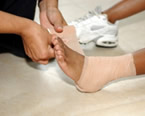 The sprained right ankle suffered by Boston Celtics player Marcus Smart last month kept him sidelined for several games. Smart has sprained this ankle previously, though this most recent occurrence is not as severe as past cases. Many attribute the less serious sprain to the fact that Smart has consecutively taped up his ankle for all of his games, something he has done without fail since suffering ankle sprains during his rookie season.
The sprained right ankle suffered by Boston Celtics player Marcus Smart last month kept him sidelined for several games. Smart has sprained this ankle previously, though this most recent occurrence is not as severe as past cases. Many attribute the less serious sprain to the fact that Smart has consecutively taped up his ankle for all of his games, something he has done without fail since suffering ankle sprains during his rookie season.
Ankle sprains are common, but need immediate attention. If you need your feet checked, contact Dr. Nicholas Megdanis from Greater Queens Podiatry PLLC. Our doctor can provide the care you need to keep you pain-free and on your feet.
How Does an Ankle Sprain Occur?
Ankle sprains take place when the ligaments in your ankle are torn or stretched beyond their limits. There are multiple ways that the ankle can become injured, including twisting or rolling over onto your ankle, putting undue stress on it, or causing trauma to the ankle itself.
What are the Symptoms?
● Mild to moderate bruising
● Limited mobility
● Swelling
● Discoloration of the skin (depending on severity)
Preventing a Sprain
● Wearing appropriate shoes for the occasion
● Stretching before exercises and sports
● Knowing your limits can aid in prevention
Treatment of a Sprain
Treatment of a sprain depends on the severity. Many times, people are told to rest and remain off their feet completely, while others are given an air cast. If the sprain is very severe, surgery may be required.
If you have suffered an ankle sprain previously, you may want to consider additional support such as a brace and regular exercises to strengthen the ankle.
If you have any questions, please feel free to contact our office located in Bayside, New York. We offer the newest diagnostic tools and technologies to treat your foot and ankle needs.
Although ankle sprains may not be as serious as a broken ankle, they should be given immediate attention and care. An ankle sprain can lead to a significant amount of pain, as well as limited mobility. They are often characterized by the swelling and discoloration of the skin. This occurs when the ligaments are stretched beyond their limits.
The simple act of walking can sometimes cause a sprain, which makes ankle sprains a very common injury that can happen to anyone. They occur when the ankle twists in an awkward way or rolls over itself, causing a pop or snap in the tendons around the ankle. Some people are more at risk than others. These include athletes who continually push their bodies to the limits and also people who have previously suffered accidents to the feet, ankles, or lower legs.
Most of the time, an ankle sprain is not severe enough for hospital attention. There are many at-home treatment options available, including propping the leg up above your head to reduce blood flow and inflammation, applying ice packs to the affected area as needed, taking over the counter pain relievers and anti-inflammatory medication, using an ACE bandage to wrap and support the injured ankle, and most importantly, remaining off your feet until the ankle has fully healed.
Despite this, an ankle sprain can turn into a severe injury that might require hospitalization. If the ankle ligaments or muscles are damaged from a tear or rip, that is one sign that the sprain is severe enough for hospital attention and possibly for surgery. Even after the surgery, the recovery process can be long. You may need to have rehabilitation sessions administered by your podiatrist to get your ankle back to full health.
The severity of your sprain might become apparent if you are unable to stand or walk, consistent pain is occurring over a prolonged period of time, swelling is much more severe than initially present, or if you start to experience tingling or numbness. These signs may indicate that your ankle sprain might actually be a broken ankle, an injury that requires immediate medical attention.
Although they are not completely avoidable, ankle sprains can be curbed with some preventative treatment measures. These include wearing appropriate fitting shoes that not only provide a comfortable fit, but also ankle support. It is also recommended to stretch before doing any kind of physical activity, as this will help lower your body’s chance for an injury.
| Bayside Office 4401 Francis Lewis Blvd Suite L3B Bayside, NY 11361 Phone: (718) 229-0222 Fax: (718) 717-0275 | Monday: 9:30am - 7pm |
E-mail us with any questions